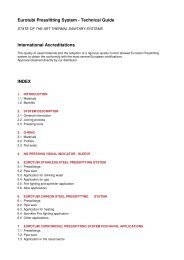corrosion of stainless steel - Damstahl
corrosion of stainless steel - Damstahl
corrosion of stainless steel - Damstahl
Create successful ePaper yourself
Turn your PDF publications into a flip-book with our unique Google optimized e-Paper software.
Introduction<br />
Stainless <strong>steel</strong><br />
is an either/or<br />
material<br />
This is particularly true <strong>of</strong> <strong>stainless</strong> <strong>steel</strong>. The right <strong>steel</strong> must be selected<br />
for the right task; the right jointing method must be employed; and the<br />
right mechanical and chemical finishes must be applied. And even when<br />
all <strong>of</strong> this is done, the user must ensure that the <strong>steel</strong> is not exposed to<br />
conditions that it cannot endure; otherwise, the <strong>steel</strong> will easily become<br />
much less <strong>stainless</strong> than intended.<br />
For those used to working with low-alloy carbon <strong>steel</strong>, the switch to <strong>stainless</strong><br />
<strong>steel</strong> can be something <strong>of</strong> a culture shock. The use <strong>of</strong> carbon <strong>steel</strong> and<br />
galvanised <strong>steel</strong> most <strong>of</strong>ten involves a 'calculated risk', as the user's equipment<br />
will slowly deteriorate by <strong>corrosion</strong>. This means that, if the <strong>corrosion</strong> speed<br />
can be determined, the equipment's service life can be calculated. Stainless<br />
<strong>steel</strong>, on the other hand, is much more <strong>of</strong> an 'either/or' material: either it<br />
works well and the equipment's lifetime is practically endless, or it suffers<br />
from <strong>corrosion</strong> and the service lifetime is extremely short.<br />
This either/or quality also means that the consequences <strong>of</strong> improper<br />
treatment are much greater with <strong>stainless</strong> <strong>steel</strong> than with caron <strong>steel</strong> or<br />
galvanised <strong>steel</strong>. A mistake with a galvanised piece <strong>of</strong> equipment may result<br />
in a service life reduction from 20 to 15 years, while improper treatment <strong>of</strong> a<br />
<strong>stainless</strong> <strong>steel</strong> construction can reduce the service life from eternity to just<br />
a few months. Stainless <strong>steel</strong> is a more 'obstinate' material than galvanised<br />
or carbon <strong>steel</strong>, and the requirements for the various links in the production<br />
chain are thus greater.<br />
In order to obtain the most from <strong>stainless</strong> <strong>steel</strong>, it is therefore incredibly<br />
important to become familiar with the material in question. For example:<br />
Why is 'acid-resistant' <strong>steel</strong> better than ordinary <strong>stainless</strong> <strong>steel</strong>?<br />
Is there a <strong>steel</strong> type more resistant to <strong>corrosion</strong> than acid-resistant<br />
<strong>steel</strong>?<br />
Why shouldn't we allow bluish heat tinting near weldings?<br />
Why does lack <strong>of</strong> bonding constitute a serious reduction in<br />
<strong>corrosion</strong> resistance?<br />
Why is fouling a problem?<br />
What makes ordinary sea salt so terribly corrosive?<br />
Why do cracks emerge directly beside the welds rather than through<br />
them?<br />
Why is low carbon <strong>steel</strong> advantageous?<br />
Why do iron contaminations create cosmetic defects?<br />
Why is coarse grinding work worse than a fine one?<br />
What does pickling entail, and why should the pickling be<br />
performed after the welding process?<br />
3<br />
RS for alle.indb 3<br />
9/29/2011 12:44:11 PM

















